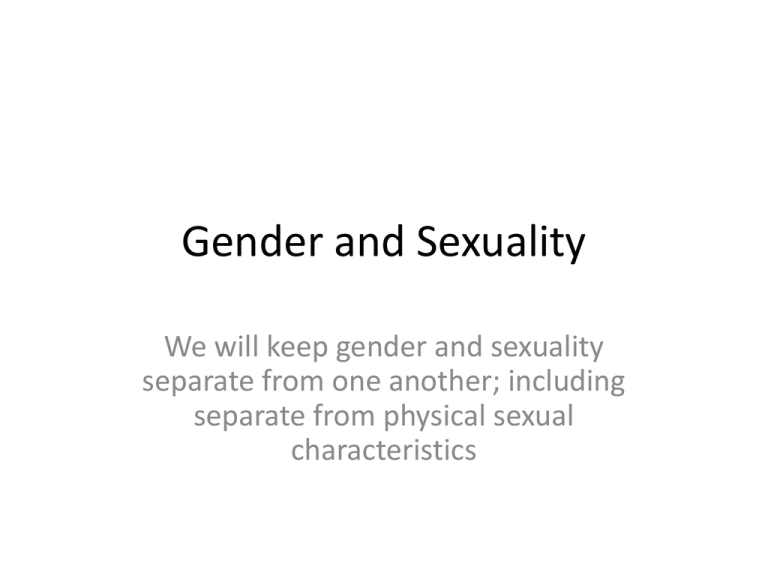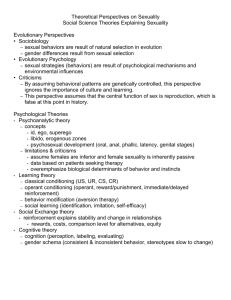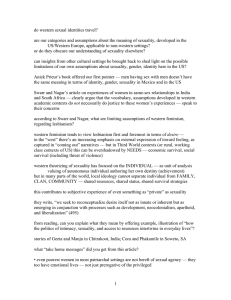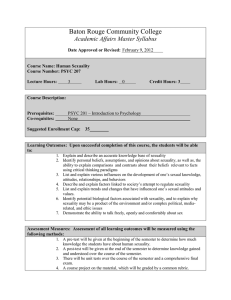
Gender and Sexuality
We will keep gender and sexuality
separate from one another; including
separate from physical sexual
characteristics
Cultural construction of gender
• Physical sex characteristics and gender are different
• Different roles, behaviors, personality characteristics,
emotions, and development of men and women not
universal and not a function of physical sex differences.
• Gender as performative
• Some cultures recognize more than two genders: a
third gender (hijra of India, xanith of Oman, mahu of
Tahiti, two-spirit among Native Americans. A gender
identity, not a sexual identity.
Caster Semenya,
South African 800m runner
Hijras of India: A Third Gender
• Hijras born as men but dress
and live as women (including
in sitting and walking
posture)
• Their genitals are removed as
a sign of religious devotion.
• They are followers of a Hindu
goddess and members of a
religious cult.
• They earn their living
performing at life cycle
rituals (marriages, births)
Two-spirits among Native Americans:
A Third Gender
• Man who dressed in women’s clothing, engaged
in women’s work, and had special supernatural
powers and privileges
• Some women also were two-spirits, but less likely
to happen
• Documented among 130 Native American groups
• Different special roles: conveyors of oral
traditions and songs; foretellers of the future;
conferrers of lucky names on children or adults;
matchmakers; makers of feather regalia for
dances; special role players in the Sun Dance
“Female Husbands” in Africa
• Among Igbo (of W Africa) and
Nandi (of East Africa)
• Usually, a post-menopausal,
childless wealthy women married a
woman to gain status and children
to whom to pass on their wealth
• In a sense these women became
men
Men and Women in Nicaragua
Men
Women
“Gender is not only the social construction of
social difference, that is, of distinctions between
male and female, but also a primary site for the
production and inscription of more general
effects of power and meaning, a source of
tropes that are key to the configuring of
domination and subjection.”----Ana Maria
Alonso, Thread of Blood (1995), p. 76
•
•
•
•
Questions:
Dulce Mendez
Andrew Campbell
Sara-Ashley Kinney
What views of formal marriage
illustrate about gender relations
• Mckayla Justice
What desmoche illustrates
about gender relations
What Zelmira illustrates about gender relations
Cultural construction of sexuality
• Diversity in sexual practices, explicit
discussion or silence around, sexuality and
marriage, as well as same-sex or other-sex
partners
• In the West: homosexuality/heterosexuality
(gay/straight) as opposites; later
modification with LGBTQAI (recognizing a
plurality of sexualities)
• In Nicaragua: cochón
• Spanish coming into American
villages were shocked to see
men dressed like women
• They justified conquest
through native Americans’
sodomy (as a sin)
• An example of how sexuality
can be intertwined with
dominance
• The cochón is due to
syncretism between Iberian
and indigenous sexual role
systems
• What is a synonym for
syncretism?
Cochón
• How does this sexual identity differ from “gay”
in American usage?
• Does “homophobia” exist? p. 269
• Normally stigmatized but different kind of
stigma than “homosexuals” in the West
• E.g., they have a prominent role in annual
festival of Santo Domingo
• Lancaster’s sexual status: Qs by Mary Ellen
LaRosa and Anon
Did the Revolution change norms
about gender and sexuality?
• Question by Julio Clemente
Western worldview on sexuality as a
form of globalization
• Are Western
conceptions overrunning local
conceptions?
• Lancaster’s view, p. 25455












